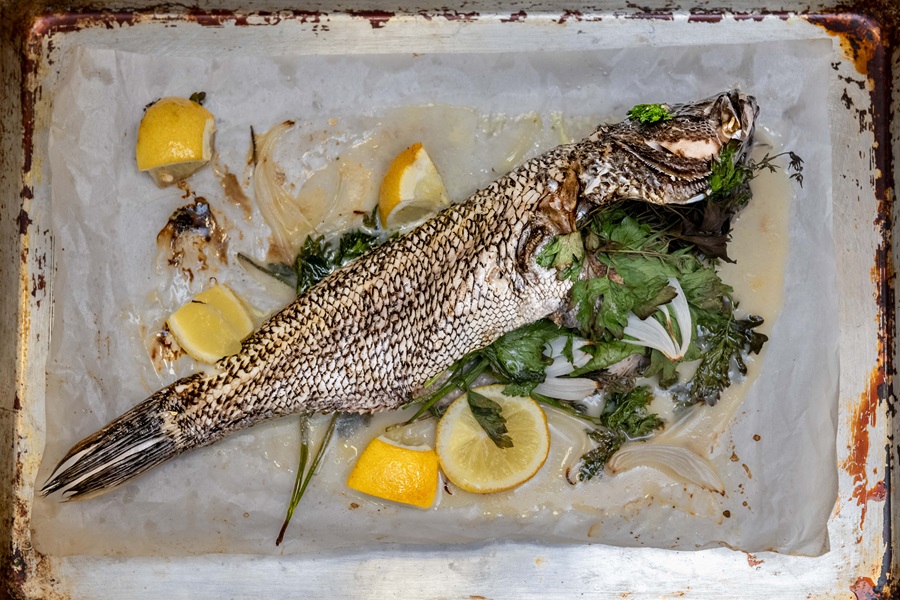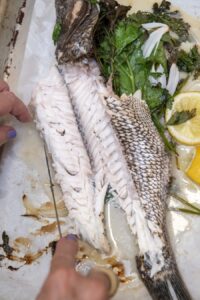It’s hard not to brag about the wonderful seafood we have here: the freshest bluefish, meaty striped bass, pearly scallops, hard and soft clams, and world-class oysters. I enjoy salmon and shrimp as much as the next person, but I am fierce about our local fish.
If you ask me, the fun of fish cookery starts before you even get to the kitchen. For those who go fishing, it starts with a lucky adventure, but for most of us the action starts in the market. A good fish market presents an inspiring still life of whole and filleted fish on glistening ice and piles of gorgeous shellfish. But I love the human scene at our local fish markets, too: the unsure cooks being schooled by the sometimes-salty fishmonger; kids at the lobster tank squealing as the crustaceans sail and flap when lifted to the scale; a discriminating host choosing dinner for a houseful of guests. Out here, when I snag a bundle of razor clams, catching up with a neighbor on town politics is part of the recipe.

You can’t plan what to cook until you get there. Dinner depends on a boat’s good catch: what fish are running, the weather, and how the fish were handled from ship to shore. This is a welcome divergence from the predictability of supermarket proteins sealed in plastic. It’s what I love best about cooking fish.
For fillets, I look for those that are firm and plump. If it’s skin on, it should look vibrant. When there are whole fish in the case, the ones with clear eyes, lively color, and moist red or pink gills get my attention.
Now’s the time to look for whole black sea bass. I am a fan of this white-fleshed fish, which is in the same order as red snapper. It’s a thrill to see this fish more often in our markets, though the fact that it’s being caught more in local waters is a good news-bad news reality.

Black sea bass migrate along the East Coast, and since 2010, while landings in the southern Atlantic are down 50 percent, in New England they’re up 260 percent, according to the Cape Cod Fishermen’s Alliance. They are great eating and represent an increased resource for fishermen here. But their higher numbers are a sign of the effects of climate change as the fish move away from rising temperatures in southern waters.
I talked before the season with Kurt Martin, an affable native Cape Codder who trap-fishes for black sea bass in Nantucket Sound. He’s been fishing since the 1980s, when he was in his teens, and until last year, weir-fished in the Sound from Chatham to Cotuit. That’s an ancient technique that corrals fish in a series of nets set in the water on poles. This season, because of the seals getting into the weir, he is using pots to catch black sea bass ranging from 1½ to 2-plus pounds. On a good day, he lands about 500 pounds of fish. The season lasts until the quota of about 900,000 pounds is met in early September.
This plate-size fish yields fillets that are perfect for a quick sauté, but ask Martin the best way to cook sea bass and he answers with a question: “What’s better, a dry chicken breast or a moist whole roasted chicken?” Cooking these fish whole is hands down the best way to go, he says, a method that’s simple but also special. Martin wishes more fishmongers sold this fish whole.
Even Americans who have been weaned off fish sticks still seem to be intimidated by whole fish. If you’re one who is, draw some culinary courage, because this is a delicious way to go. The prep can be done by the fishmonger. A small one-pounder makes an individual portion, or a larger fish serves two. I often roast two smaller fish side by side.

Ask the market to scale, gut, and gill the fish, then trim the fins and tail. After that, the cooking is easy. Stuff the cavity with sliced citrus and a bunch of herbs and then roast at high heat on a lined sheet pan to catch all the juices. When you cook it on the bone, the fish stays moist and flavorful. I also lean toward this method over grilling because the pan juices are sublime sopped up with bread or spooned over new potatoes. The green sauce is open to improvisation depending on what herbs you fancy or have in your garden.
Boning the fish once it’s cooked is much easier than filleting it raw. No special equipment is needed — eaters can do it armed with nothing more than two spoons. But if you want to fillet each fish for your guests, a little tableside style can make for a dramatic presentation (Serious Eats has a helpful video on how to carve whole fish). Whether you let guests carve their own or you fillet the fish for them, don’t stress about perfection.
There is a romance and elegance to cooking fish this way, but maybe even more than that, I love that it connects me to the natural world and to the people who make life here so special.
ROASTED BLACK SEA BASS WITH GREEN SAUCE
Serves 2
For the fish
1 whole black sea bass, about 1¾ to 2 lbs., cleaned*
Kosher salt and freshly ground black pepper
1 lemon
4-6 sprigs fresh thyme
4-6 sprigs Italian parsley
3-4 thin slices spring onion, shallot, or red onion
Extra virgin olive oil
* You can ask the fishmonger to scale, gut, and gill the fish and trim the fins and tail.
For the green sauce
1 cup loosely packed basil leaves (or basil and tarragon)
1 cup loosely packed flat parsley leaves (or parsley and mint)
¼ spring onion, ½ shallot, or 3 Tbsp. minced red onion
2 tsp. capers
½ tsp. finely grated lemon zest
1 anchovy, optional
1 small clove garlic, smashed
Pinch red pepper flakes
1 Tbsp. wine vinegar or lemon juice
1/3 cup extra virgin olive oil
Kosher salt, to taste
- Heat oven to 425° F. Line a baking sheet with parchment or foil. Season the fish cavity with salt and pepper. Place the herbs, onion, and a couple of thin lemon slices in the cavity and tuck extra onions and herbs around the fish. Brush the fish all over with olive oil and season again with salt and pepper. Add remaining lemon, cut in halves or quarters, to the pan.
- Roast the fish until an instant-read thermometer inserted into the thickest part of the fish registers 130-135° F, 18-20 minutes. Let the fish rest for a couple of minutes before carving.
- While the fish cooks, make the sauce. Put all the ingredients except the oil in a blender with a couple of tablespoons of water. Slowly drizzle in the oil while blending. If the sauce is too thick, adjust it by adding a bit of water. Season with salt and pepper to taste.
- To bone the fish, use a spatula to transfer it to a platter, then use spoons or a table knife to remove the small dorsal and ventral fin bones along the top and bottom of the fish. Cut along the collar bone, then cut down the center line of the top fillet — your knife or spoon will go down to the spine. Gently lift the fillet halves from the bone and transfer them to a plate. Remove the aromatics from the cavity. Grab the tail and lift the fish frame from the bottom fillet, using your spoon or knife to remove any bones that stick to it, and add the fillets to the plate. The skin is delicious and very mild and can be left intact, but that is up to you. Reserve the head; there are some fabulous nuggets in the cheeks. Spoon any pan juices over the fish and serve with the sauce.
